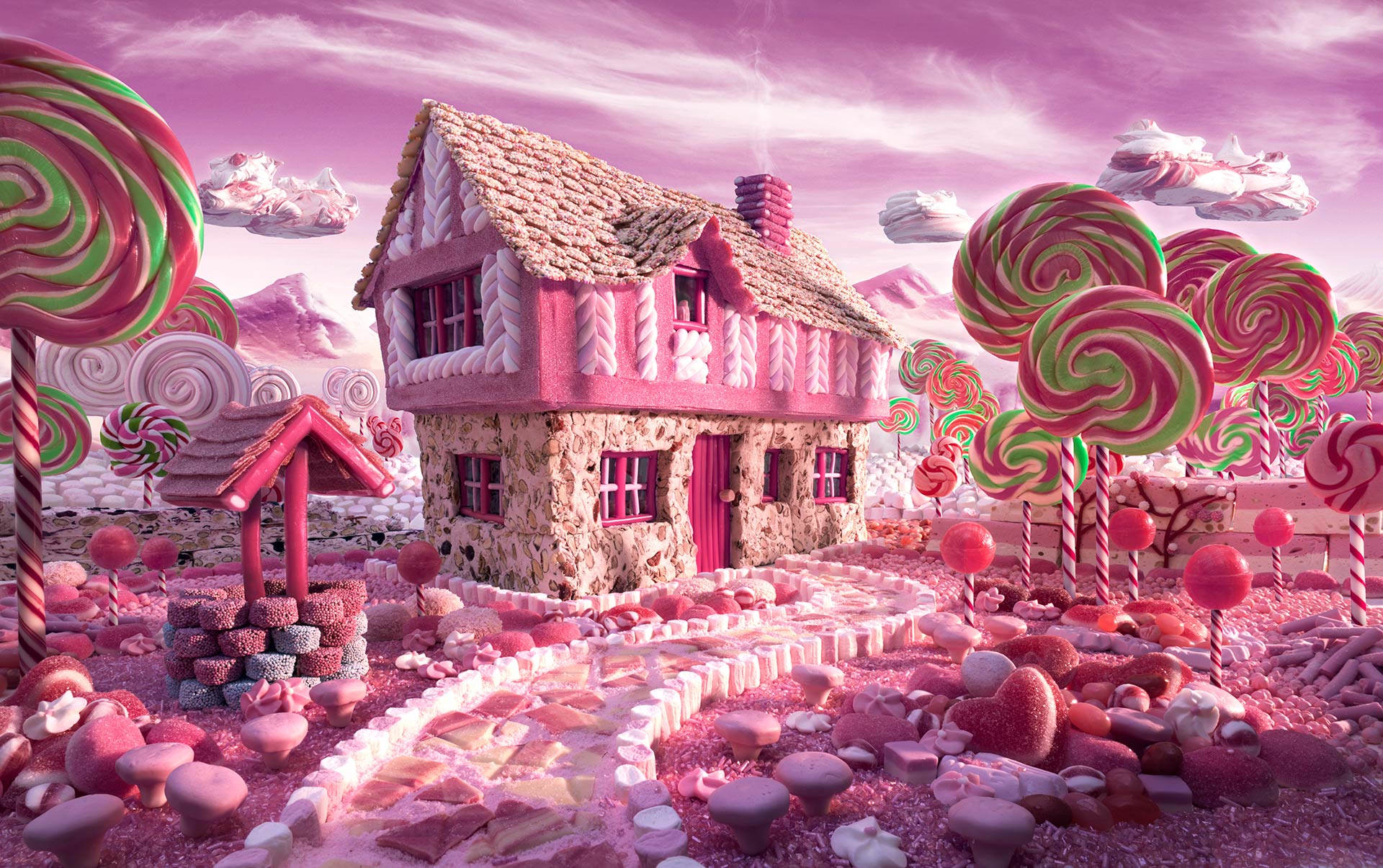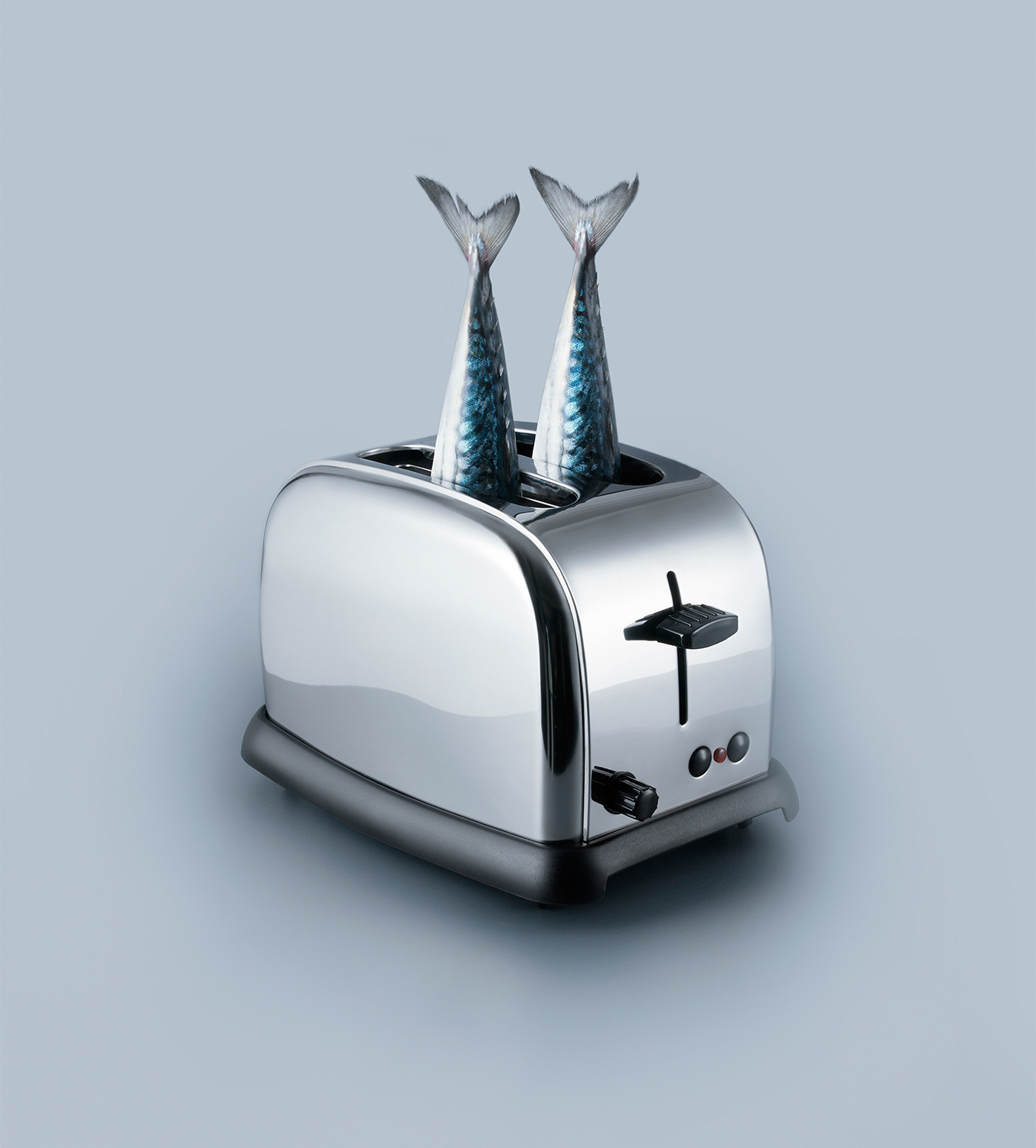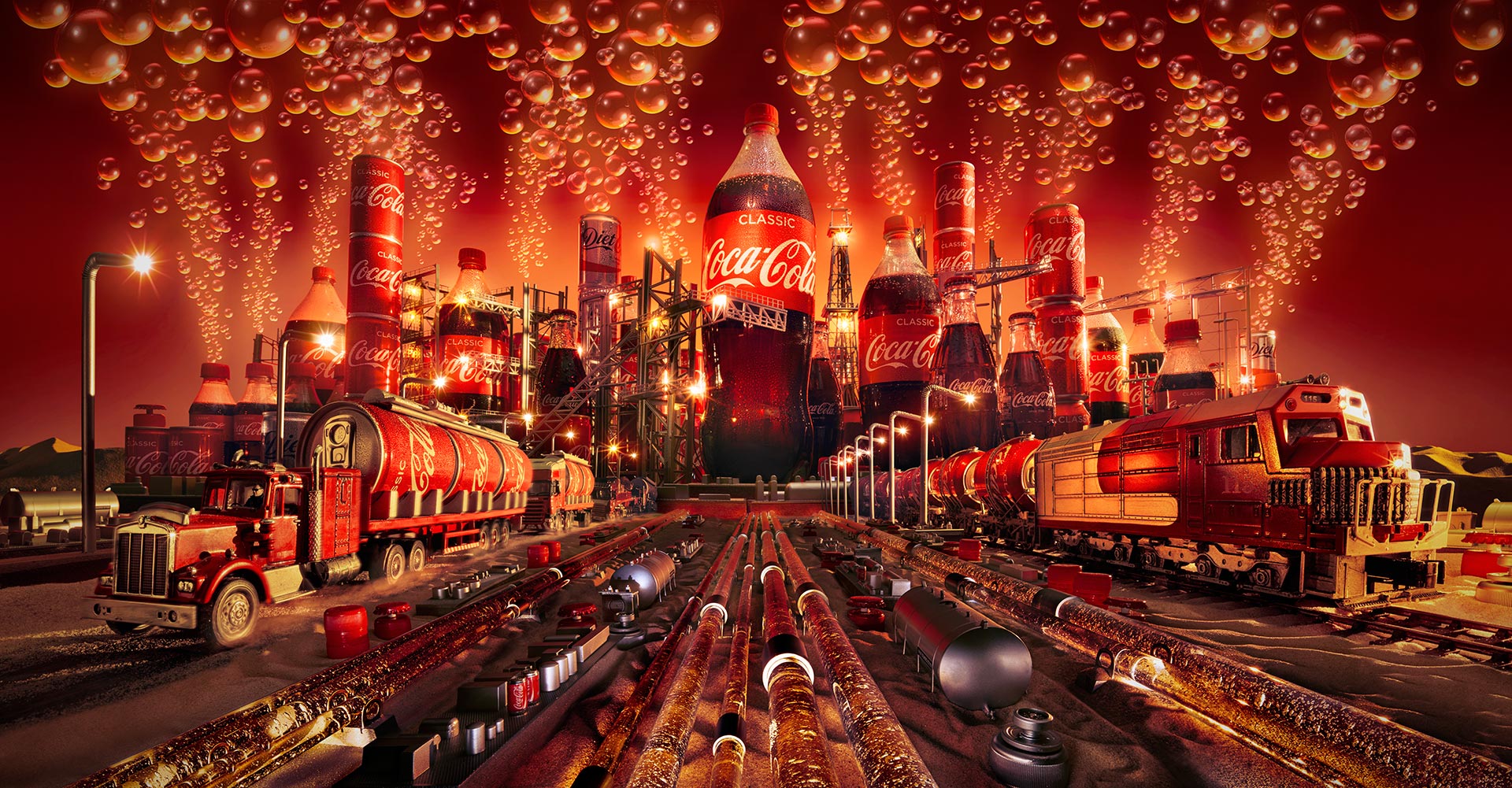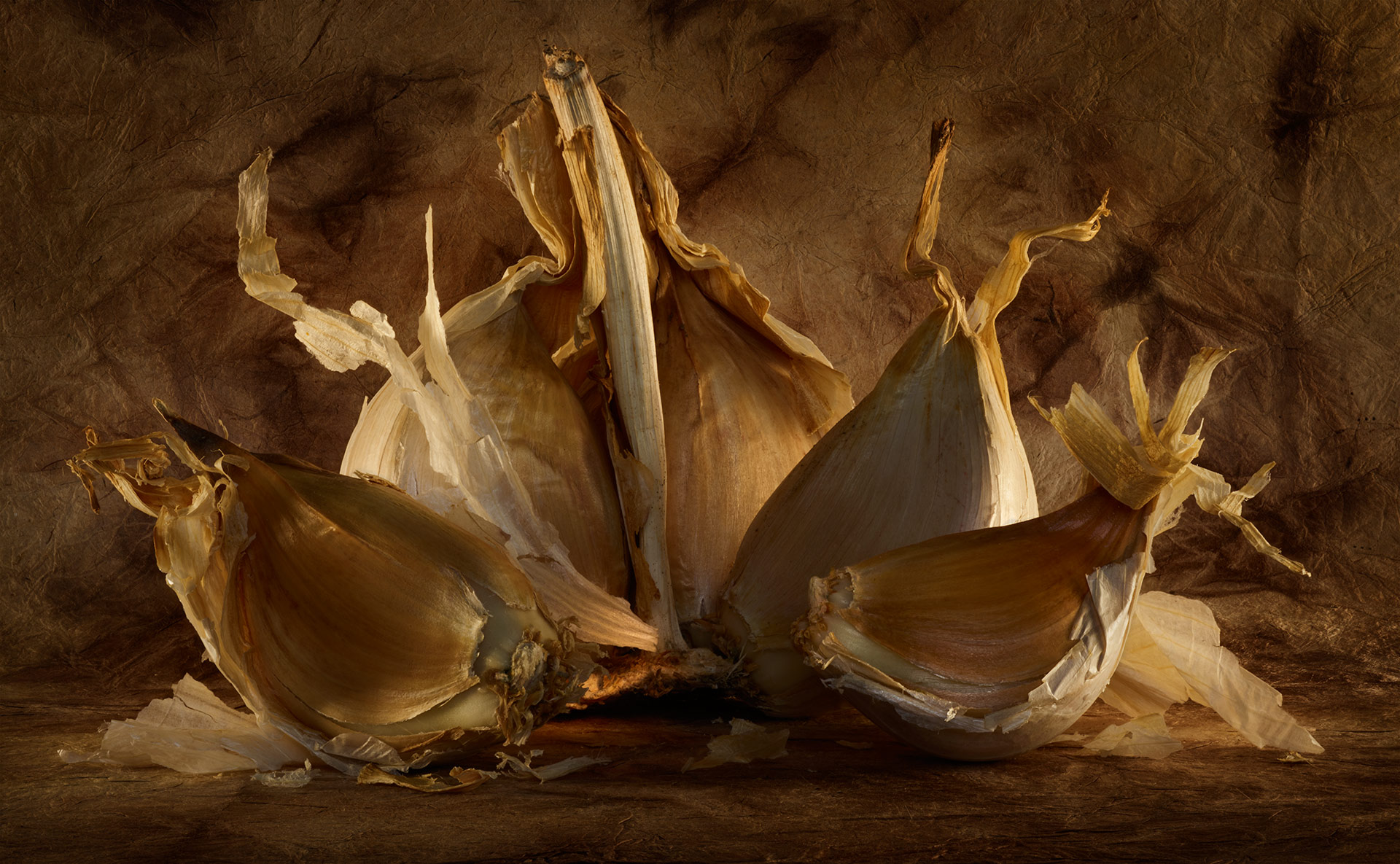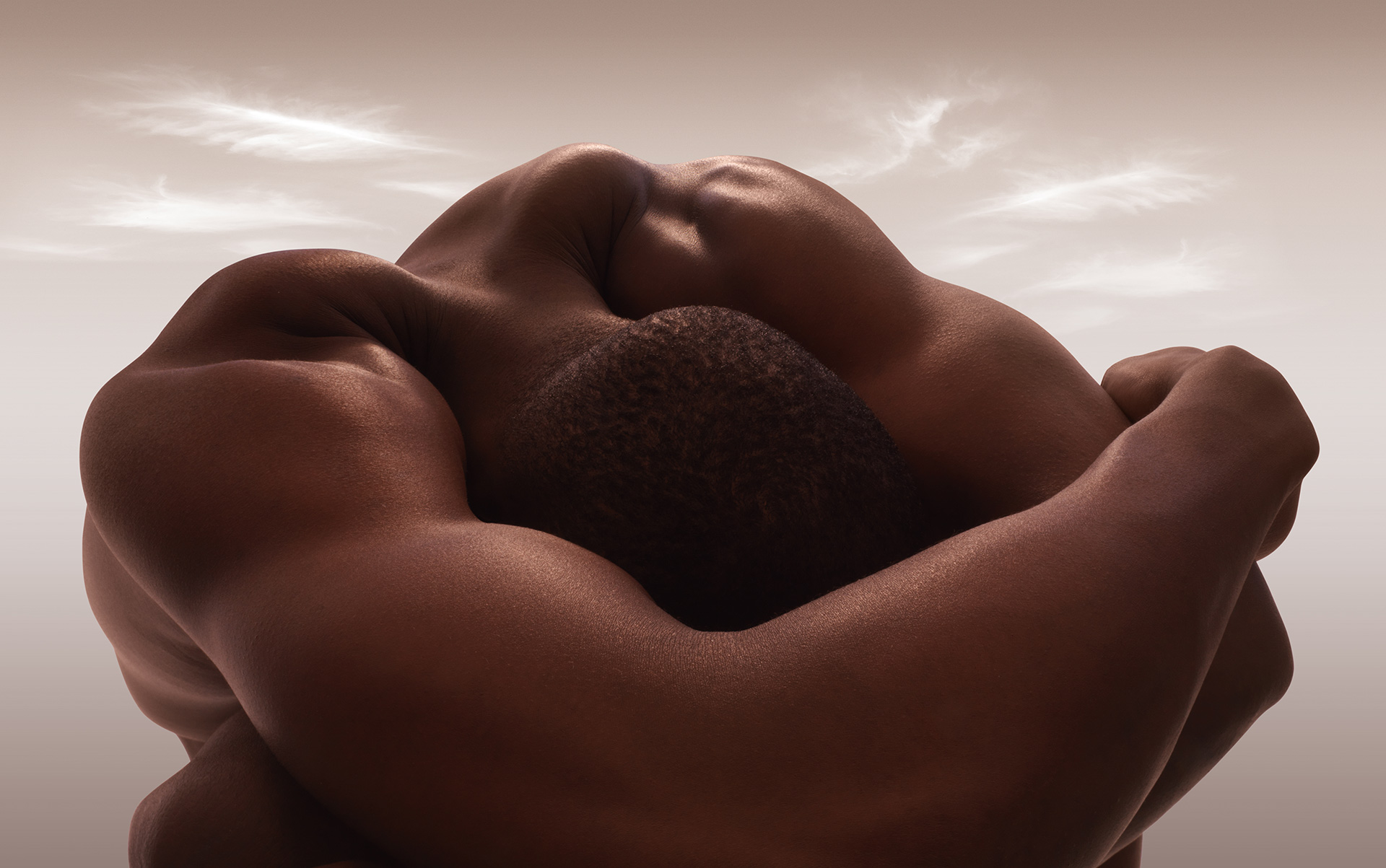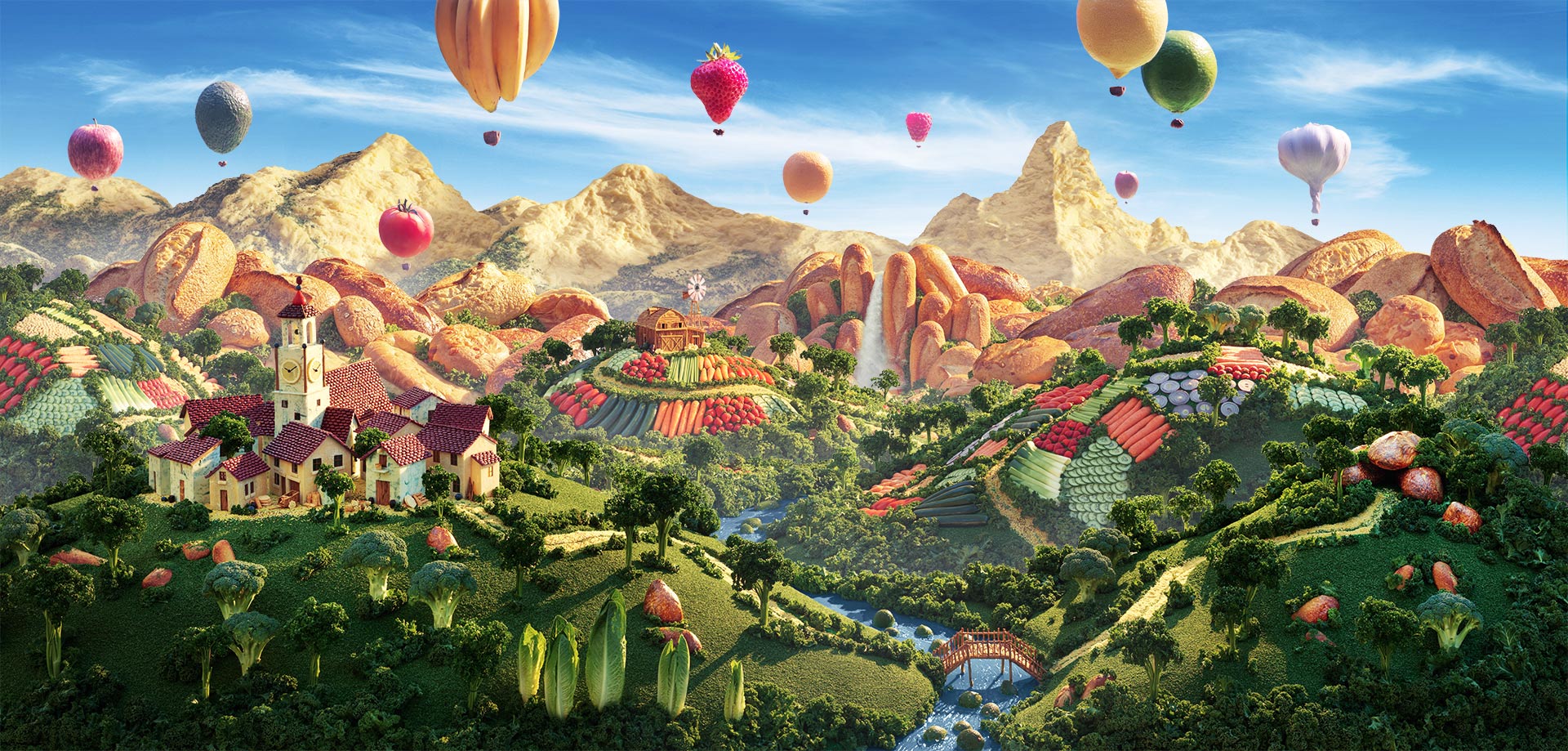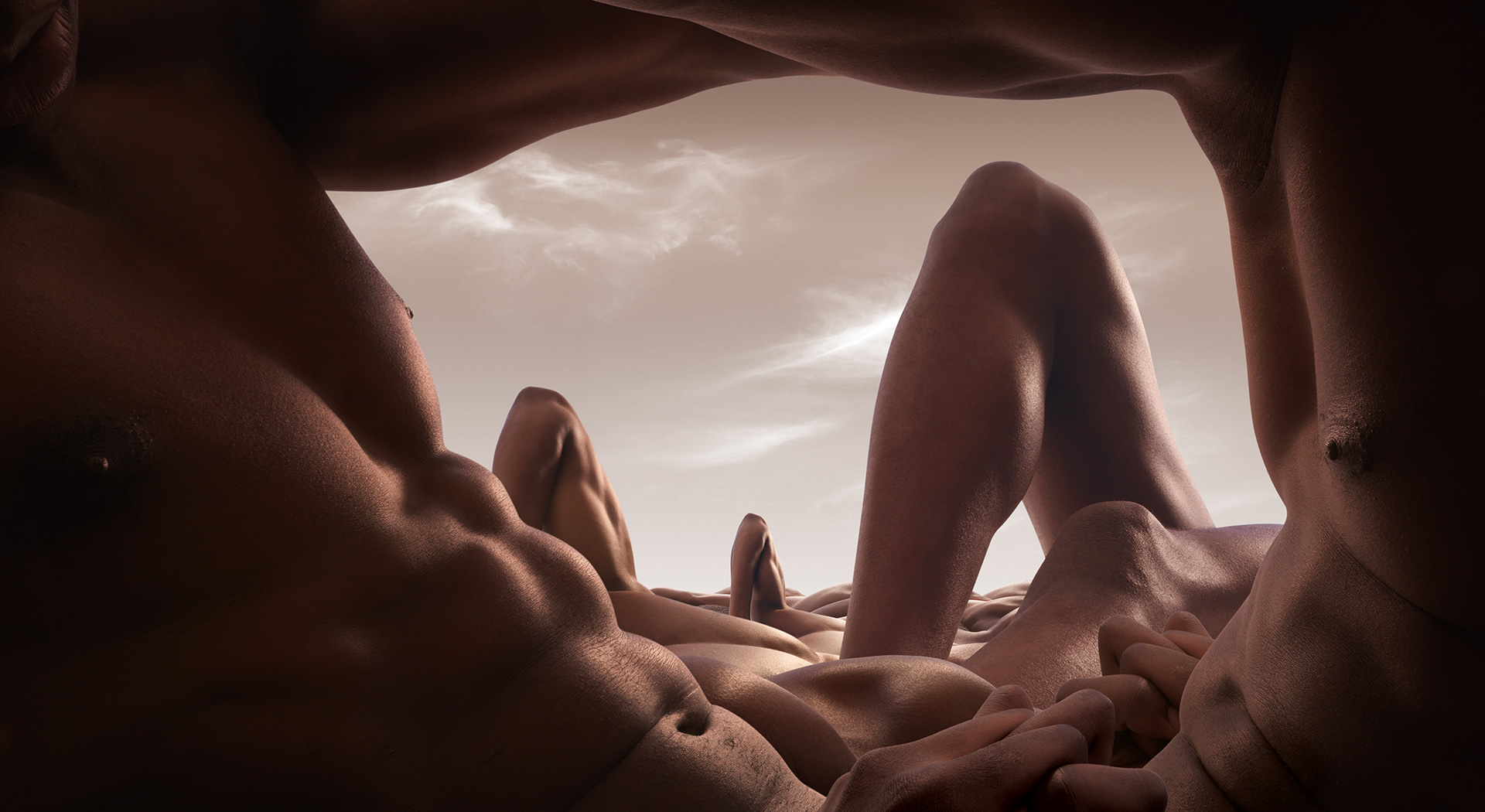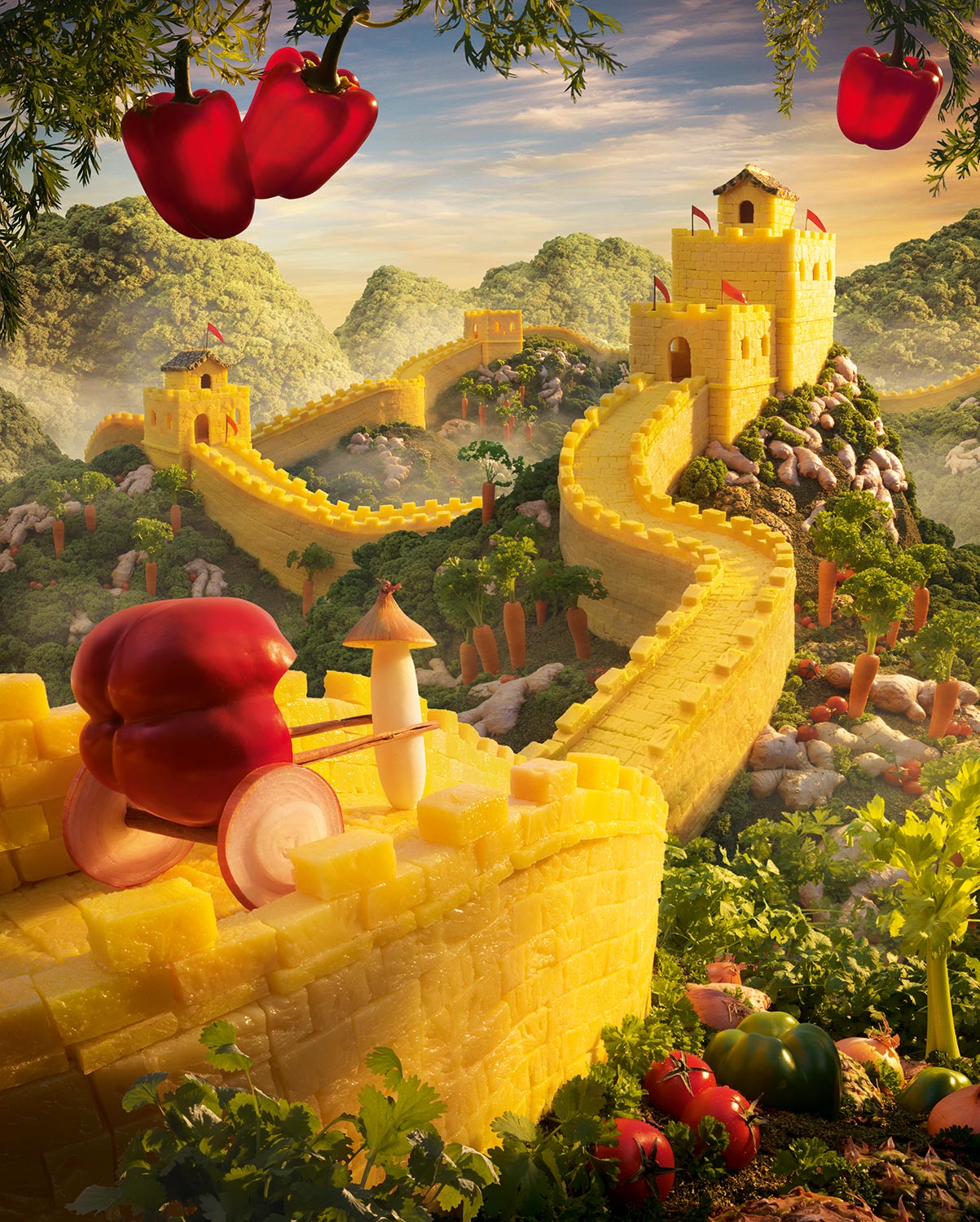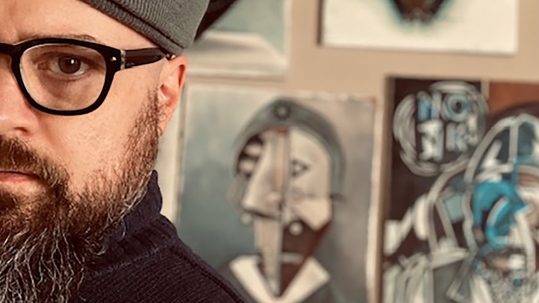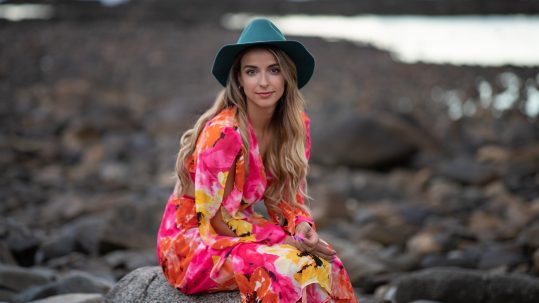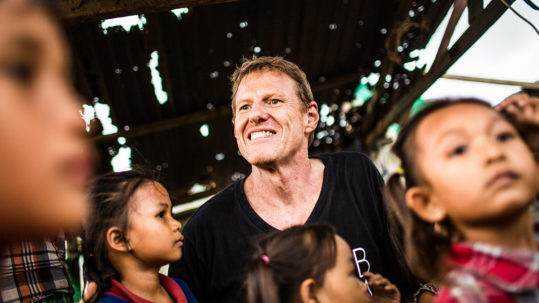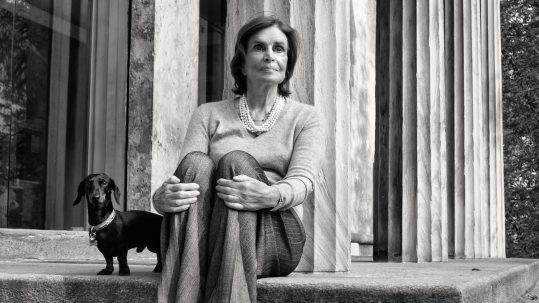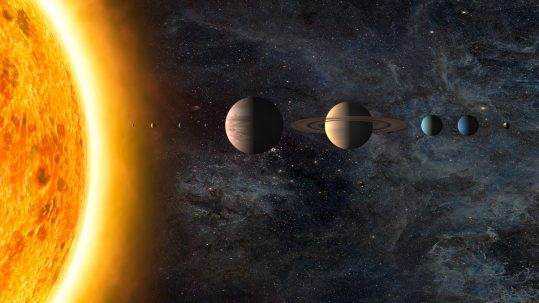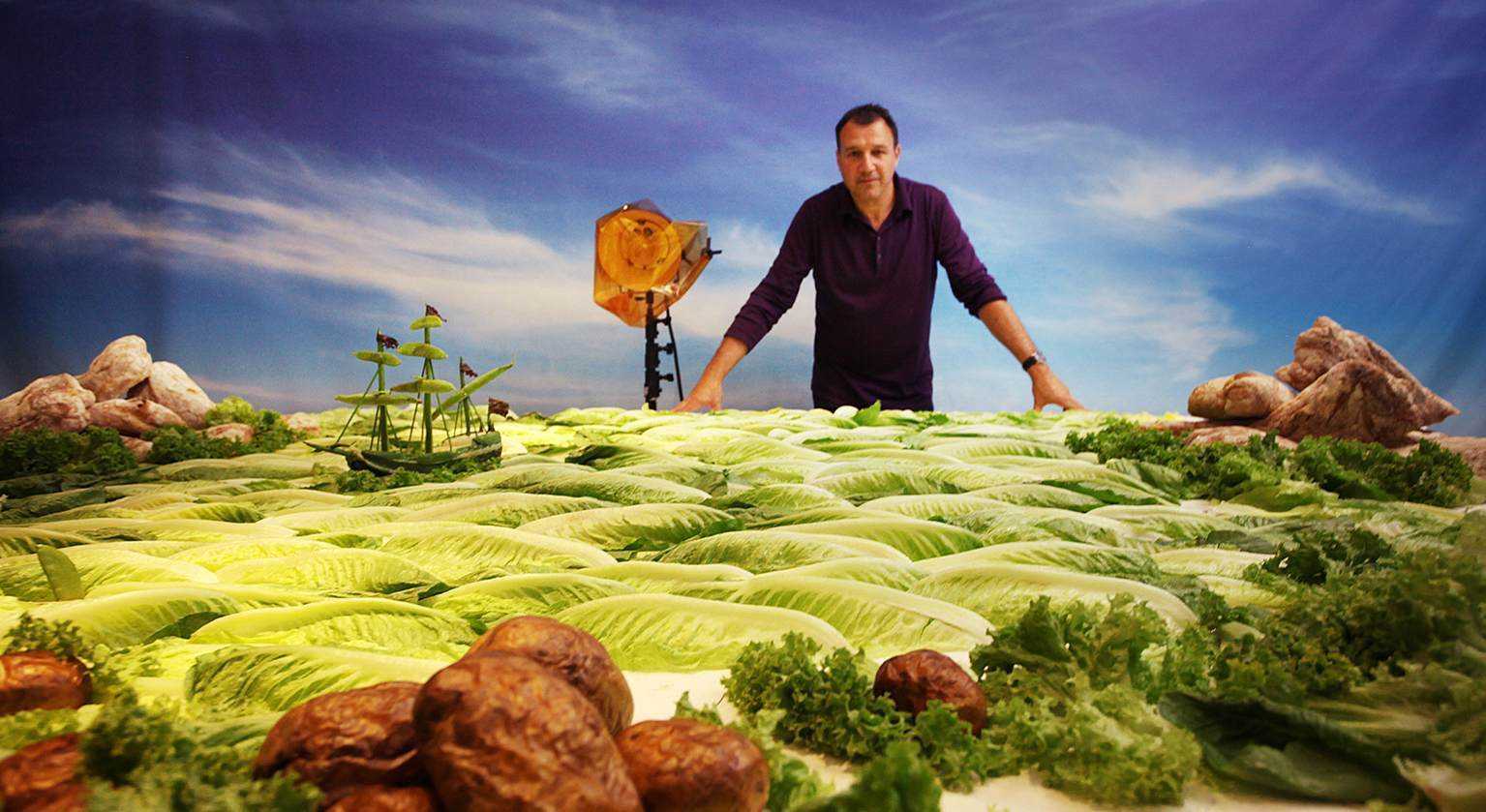
04 Oct Carl Warner
Photo: Courtesy of Carl Warner
CARL WARNER
Carl Warner burst into fame a few years ago, showcasing in an article, his unique way of capturing food. Creating landscapes out of broccolis, mushrooms or pineapple, cities made of spoons or carpet, Carl Warner redefined the norm entirely, reinventing the concept of food photography with the aim of also serving a good cause.
By Victoria Adelaide | OCT 23. 2017
Victoria Adelaide: When did the idea to create ‘foodscape’ pictures come up?
Carl Warner: It started in 1999. I was in a food market and I found some amazing Portobello Mushrooms. I thought, ‘if I hold them up they look like trees from an alien world or something like that’. I brought them back to the studio and I made a landscape with them; that was the first one. I wasn’t sure if it would work or not but it really looked very interesting, so I thought I’d try to develop it more. I was working in a retouching house; it was a day before Photoshop, and I had a place where I was retouching with other photographers and art directors from different parts of the world. There was an art director from Finland who saw the mushroom landscape and said, ‘do you think you can do that with salmon’? So, we got some smoked salmon which looked like water; that was the second one that I did and that was amazing because it was much better than the mushroom one and it looked very realistic. From there, I ended up doing several more for a Finnish art director, for a buffet company in Finland. Then it grew and grew and grew and it wasn’t really until 2008 when I had done about 25 pictures maybe, that all of a sudden a newspaper got interested; they wrote an article on it, and everything went viral and ballistic. Then I got this international acclaim and I started to do lot more commissions, and then I started to move into television, using cameras to fly through these things. It’s been quite an amazing career that developed from seeing a mushroom in a market place (laughs).
VA: What is the process to create a foodscape, and how long does it take?
CW: First, I see the picture in my head, so I do a drawing of what I imagine. With the Great Wall of China for example, everybody knows what it looks like so I would do a drawing that captures the snaking movement of the wall across the hills, I would probably look on the internet. Years ago, before the internet, I would have flown to China. I have done some commissions where I’ve been to various places, but of course not every job has the budget that allows me to do that. It’s easy to go online to look at pictures of the Great Wall of China and get inspired. So, I draw a sketch of the picture I see in my head and then it gets shown to the clients, to my team of model makers and food stylists. Then we sit down and discuss what we’re going to make things out of. The Great Wall was done for ‘Uncle Ben’s’, the rice company; they wanted to do sweet and sour sauce. If you look closely, the Great Wall of China is made out of pineapple chunks and that is how the process developed from deciding what we’re going to make things out of. If somebody comes to me and says, ‘make me a food picture and you can use whatever you want’, that’s quite difficult, it’s much easier if people tell you exactly what they like, if they want a landscape made out of chocolate and olives, for example. So, all of that goes into the process of what I’m drawing. I’m kind of thinking, ‘oh yes, I’ll make that with carrots, I’ll do this house made of broccoli’; now I understand what things work well and what looks good. So, once we’ve got a drawing and a decision on what everything is going to be made of, the food stylist goes and gets all the food and the model maker starts helping me build everything, and then we photograph it. So, normally a foodscape can be shot in one day or two days. If it’s really big, it can take three to five days. We photograph in sections, hills, middle ground, foreground, and then when it’s shot, we do the retouching, the Photoshop work which is more to enhance the picture than to make it.
VA: What do you do with all the food afterwards?
CW: A small amount may have perished and would have been thrown away, but the majority of the food is given to the crew that I work with. If there is a lot of food left over, in London where I shoot, there is a charity that I’m supporting called ‘City Harvest’, so we give them a call, they send a refrigerated truck, they pick everything up and then it goes either to the ‘Food Bank’ or to homeless shelters. We make sure there is as little waste as possible. On the subject of waste, some people say this is terrible, there are people starving in Africa and I’m making pictures out of food. They get very upset with me. I don’t ignore these emails; I write back to say that we’re probably only using as much food as a family’s weekly shop and the food is given out either to the crew or goes to the homeless shelter through the City Harvest Charity. But more importantly, there is no waste of food even if it’s not eaten. If the image is being used to sell a product, it helps the economy, it creates jobs, it brings the company profit or sometimes my pictures are used in children’s hospitals, by nutritionists, in schools for arts projects, or we auction them for charity. So, thanks to the images, the food is immortalized for years to come. I still sell prints and pictures of the broccoli forest which was done nearly 17 years ago. These broccolis may have gone into somebody’s stomach for the day and kept him fed, but my pictures will last for many many years to come. And these pictures are being used for some very good causes, especially where there is a big need for food and nutritional education. They are used in children’s school books in order to get children interested in food, and to get them thinking about eating different types of food. So there’s a really good use of the pictures and it’s the opposite of what people may think; it’s the complete antithesis of waste and it is being put to good use.
Photos: Carl Warner
VA: When it comes to consuming food, do you look at it in a different way; what are your food habits?
CW: I think I’ve always been a keen cook, I love cooking and my wife loves cooking. We really enjoy great food; we love traveling and going to fantastic restaurants, not just a Michelin Star restaurants but I love local food. Some people say, that it makes them feel so hungry when they look at my pictures. I don’t get that; I never feel hungry looking at my pictures, because the majority of the food isn’t cooked, it’s raw ingredients. It’s more the celebration of the aesthetics of food, and for me, looking at food as a way of creating and constructing a foodscape image, it means I’m looking at food with a completely different hat on than if I’m looking at food to cook for dinner this evening.
VA: You say that you see beauty in common things nobody generally notices; is it something that applies also in your life as a person?
CW: Somebody once said that beauty is in the eye of the beholder. A rusty chain can be very beautiful, something that’s decaying can look very beautiful in its state of decay. I think the idea of beauty is not just a beautiful sunrise or a rose. I think we look for beauty within our world, and we all see beauty in different ways. A man could look at a girl and say she is beautiful and somebody else would say ‘oh no!’; that person can’t see it. But he is attracted to that girl and he thinks she’s beautiful, it’s his perception, it’s his eyes, it’s his way of seeing that it’s the beauty that he sees within that person. Lots of people say to me that it must be so nice to do something creative for a living. But I think creativity is part of the appreciation of beauty as well. Creativity makes you turn your eyes on and switches your brain on, your head on, in order to see the things around you that are remarkable, beautiful or inspiring; they capture you, you actually feel drawn to these things.
VA: Does your background as an illustrator trigger your imagination or is it the child who still lives in you?
CW: The little boy is still there. I used to draw as a child, I was an only child, I didn’t have brothers and sisters. There was never much on the TV, you didn’t have smart phones to play with, so what did you do? You got bored, and when a child gets bored he invents his own play, he uses his imagination, he creates a world. That’s what I used to do. I used to have posters by Salvador Dali on one wall, and Roger Dean who was another artist who did the Yes album covers because I adored those worlds. With a pencil and a paper, you could create worlds or ideas. I used to draw spaceships, houses in the underworld, imagination is like a muscle, if you don’t take it out and use that muscle, you don’t develop your imagination. Children today are not being allowed to get bored because they always have something on their computer, their phone to occupy them. Getting bored makes your imagination work harder, and when you develop your imagination you can see things differently, you can make things out of other things; for me, it makes the world really interchangeable. I can make a city out of car parts, or I can make a landscape out of a carpet, you are making something out of something else, you are altering the world, if you like, because you make people understand that the world isn’t just one way; it’s all about how you see it. If I can make a landscape out of the contents of my fridge, what can mankind do with the contents of the planet? We could make the world a much better place if we were to actually use our creativity, our positivity and make amazing things. We all get told about the terrible things that happen in the world and yet there are so many wonderful things that happen in the world and they just don’t get reported. When children can see an adult like myself making worlds out of food and being a child, they look at me and say, ‘I don’t have to grow up, I can live my life with that child still alive’. I think that’s a good aspect of humanity, that’s something that should always be promoted.
VA: Where are you at with your children’s animation project which will help educate kids about healthy eating?
CW: It’s something that hasn’t happened yet. We have made several attempts to get it off the ground. I was in America a few times with a particular company, we were looking to develop a vehicle that was going to be used to educate children about healthy eating, to develop nutritional literacy. I think there is a massive need and a massive hole for this kind of education in schools and on TV, and if from a very early stage we can teach children that what they put in their body affects the way they think and their health, we can make a change. Young people today are too interested in smoking marijuana or introducing something else into their body or eating fast food because they want to continue playing their Xbox game. All of that food culture is the opposite of living healthily or eating healthily. I’d love to do this but without sponsorship, without backing, it’s difficult.
VA: What is the most rewarding aspect of your job?
CW: There’s two things. First of all, it’s getting an idea from the head into a final image and realizing that it’s not only as I saw it, it’s even better, that is very rewarding creatively for me. What’s more rewarding is seeing that picture looked at by people, especially children, seeing the smile on their faces, there’s a certain joy that the images bring and when people just smile I love that. For people to see my work and smile, that’s very rewarding.
VA: Is there something you haven’t tried yet that you would like to experiment with, and what would it be?
CW: I had the idea of creating a bodyscape of well-known people, sportsmen or politicians, leaders or actors, pop stars, and I thought it would be amazing to take maybe Brad Pitt’s body and create a bodyscape out of Brad Pitt; the ladies would love it! Without his face, it would just have his body. I think what was interesting about the bodyscapes is that these are our earth suits. I was going to call the exhibition ‘Earth Suits’. These bodies are the vehicles for the time we are here on the earth, and making them into a place is a very interesting concept. If I were to do a bodyscape of Brad Pitt, you would never see his face, just his body; you would be looking at the intimate parts of his hands, his arms, the back of his legs, his feet, all of these things would be like Brad Pitt’s personal earth suit and that is really something I would like to explore more. The idea of putting together an exhibition that offers an alternative to portraiture, that does not show the person’s face, just the body, I think that would be a really interesting thing to do.
VA: What are you working on now?
CW: At the moment, I’m doing an image for a new game for PlayStation. We create a scene for a PlayStation game all made out of food. I’m also developing my television reel. I’m just working on a new project which is going to combine a food world, CGI, like a spaceship all made out of spoons, and then I filmed real children, so it’s a moving image piece for my directing reel. I’m working on another project focused on making landscapes out of carpets and on other projects I can’t talk about for now…
...Creativity makes you turn your eyes on and switches your brain on, in order to see the things around you that are remarkable'``

